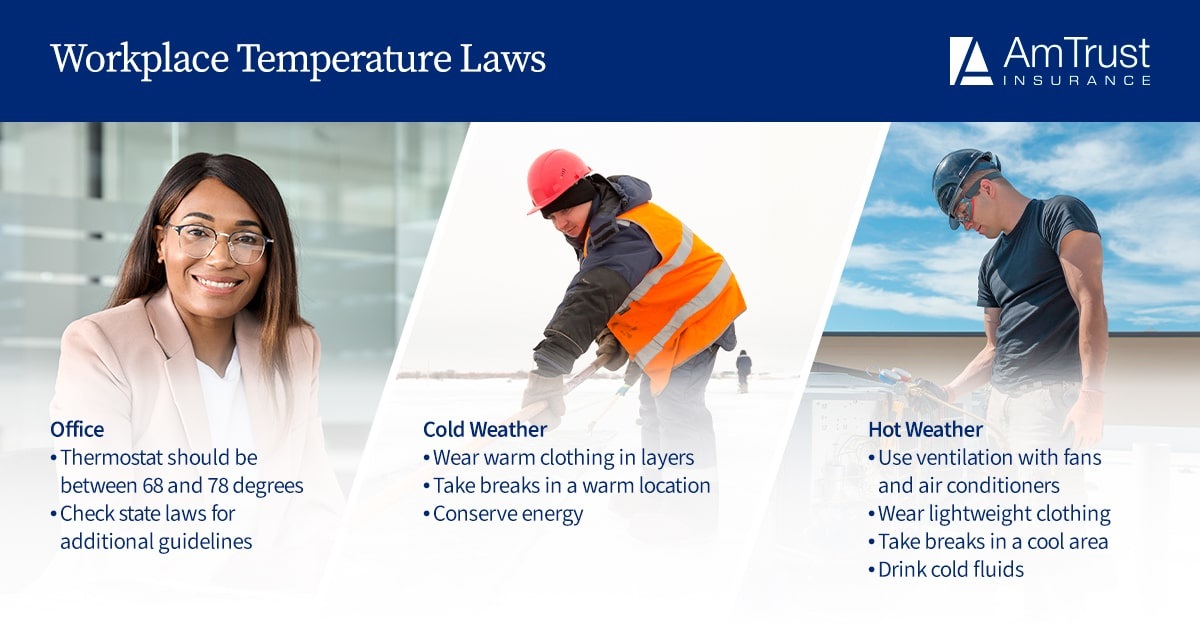Summary: Both employees and employers may wonder if there are any specific laws about temperatures in the workplace. This article discusses OSHA rules for temperature and determining extreme temperatures that can lead to unsafe working conditions.
What are the OSHA Regulations for Temperature in the Workplace?
The
Occupational Safety and Health Administration (OSHA) can’t completely resolve the thermostat conflict in your office, but they can require that employees operate in a healthy and safe work environment. OSHA understands that a comfortable temperature for one person might be too hot or too cold for another. Because of this, they cannot designate one specific workplace temperature; however, OSHA does have some workplace temperature regulations, stating that employers set the thermostat between 68 and 78 degrees. In some cases, state OSHA plans can differ from federal OSHA plans, so be sure to
check the regulations for your state.
OSHA operates under the U.S. Department of Labor, which enforces federal laws and standards for workplace and employee safety. OSHA regulations come into play when temperatures reach an extreme level to the point where dangerous conditions like heat stress or hypothermia can occur. However, room temperatures and overall air quality can impact employee productivity and performance, so employers must set a comfortable standard in their workplaces.
Energy Costs on the Rise
As cooler temperatures begin to sweep across much of the United States, some small business owners may also start looking for ways to keep their energy bills low. Electricity prices have been increasing due to the rising prices for natural gas. In fact, in May 2022, increasing food and energy costs caused
U.S. consumer inflation to reach the highest level it has been in over forty years. Turning down the heat in buildings and warehouses may seem like a natural response to lower some of those energy bills, but it's important employers consider the health and safety of their employees before doing so.
Determining Extreme Temperatures and Unsafe Working Conditions

Using a heat stress monitor, you can check conditions such as temperature, humidity or the amount of warmth radiating from a heat source. Conversely, freezing temperatures are easily identified using a thermometer. OSHA has also developed a
smartphone application that gives employers and workers the ability to determine heat index and risk level for heat-related illness. It also offers recommendations for protection measures based on risk level.
Workplace Temperature Regulations
A worker’s ability to maintain a safe body temperature ultimately determines the safety of an extreme temperature. OSHA states that the human body relies on its ability to get rid of excess heat (i.e., heat dissipation) to maintain a healthy internal body temperature. Heat dissipation happens naturally through sweating and increased blood flow to the skin. If heat dissipation does not occur quickly enough, the internal body temperature keeps rising and ultimately affects a worker’s mental and motor skills.
What is considered “extreme cold” and its effects can vary, but a cold environment generally causes the body to work harder to maintain its core temperature. Whenever temperatures reach extreme levels, heat will leave the body more rapidly and can lead to serious health issues.

Working in Extreme Heat
Heat-related illnesses such as heat stress in the workplace occur when the body cannot cool itself down and maintain a healthy temperature because the environment is just too hot. Some signs of heat stress include confusion, dizziness, profuse sweating, nausea or vomiting, rapid heart rate and more. OSHA provides additional detailed information on preventing workers from
heat exposure.
Working in Extreme Cold
Working long hours in a cold environment can leave an employee susceptible to
cold stress, which can result in several serious medical conditions. We previously mentioned that the body uses additional energy to maintain a proper core temperature. In extreme cold conditions, blood flow is shifted from areas like the hands, feet and the outer skin and redirected to the body’s core. When this happens, those areas are at an increased risk for frostbite, trench foot and hypothermia.
Frostbite is caused by freezing of the skin and the tissue underneath, resulting in severe damage that in some cases can lead to amputation. Trench foot occurs when feet are exposed to wetness in exceedingly cold temperatures, causing tissue and nerve damage, blisters and numbness. Much like frostbite, it can lead to amputation in extreme cases.
Hypothermia occurs when the body loses heat faster than it can produce it, resulting in a dangerously low body temperature, slowed breathing, disorientation and even death unless care is received immediately.
Protecting Employees from Heat and Cold Exposure
Making sure
hot work environments have proper ventilation with fans and air conditioners, allowing employees to wear lightweight clothing, and providing a cool break area with cold beverages available are a few ways to help reduce the hazards of a hot work environment.
For
cold work conditions, employees should be encouraged to wear warm clothing in layers, provided a warm location to take breaks, and have their workload monitored so energy can be conserved, allowing their body to use additional energy to maintain an adequate core body temperature.

The employer should formally monitor and document temperatures throughout the work areas and be prepared to take action when limits are reached.
Keeping Workers Safe with Loss Control Resources from AmTrust
AmTrust’s
Loss Control Department offers valuable
workplace safety resources to help small businesses create the most effective loss control program for their specific needs. From
winter preparedness resources to our information
Safety Zone articles, it’s our goal to help protect our insureds’ buildings, their contents, their income, and of course, their workers. For more information, please
contact us today.
This material is for informational purposes only. Neither AmTrust Financial Services, Inc. nor any of its subsidiaries or affiliates represents or warrants that the information contained herein is appropriate or suitable for any specific business or legal purpose. Readers seeking resolution of specific questions should consult their business and/or legal advisors. Coverages may vary by location. Contact your local RSM for more information.